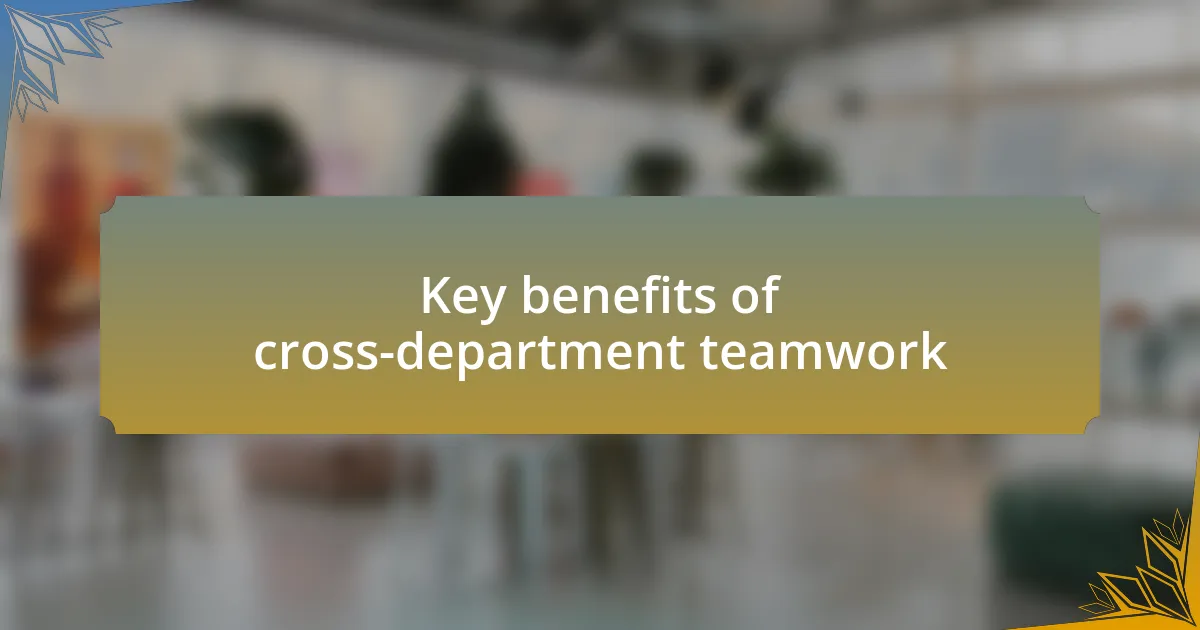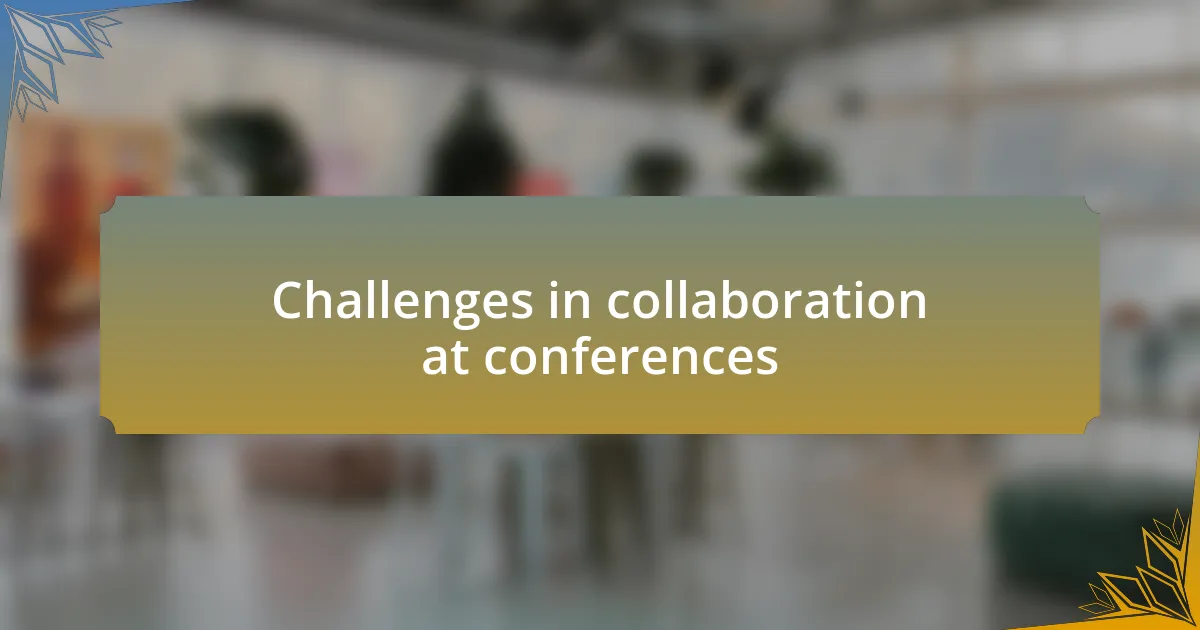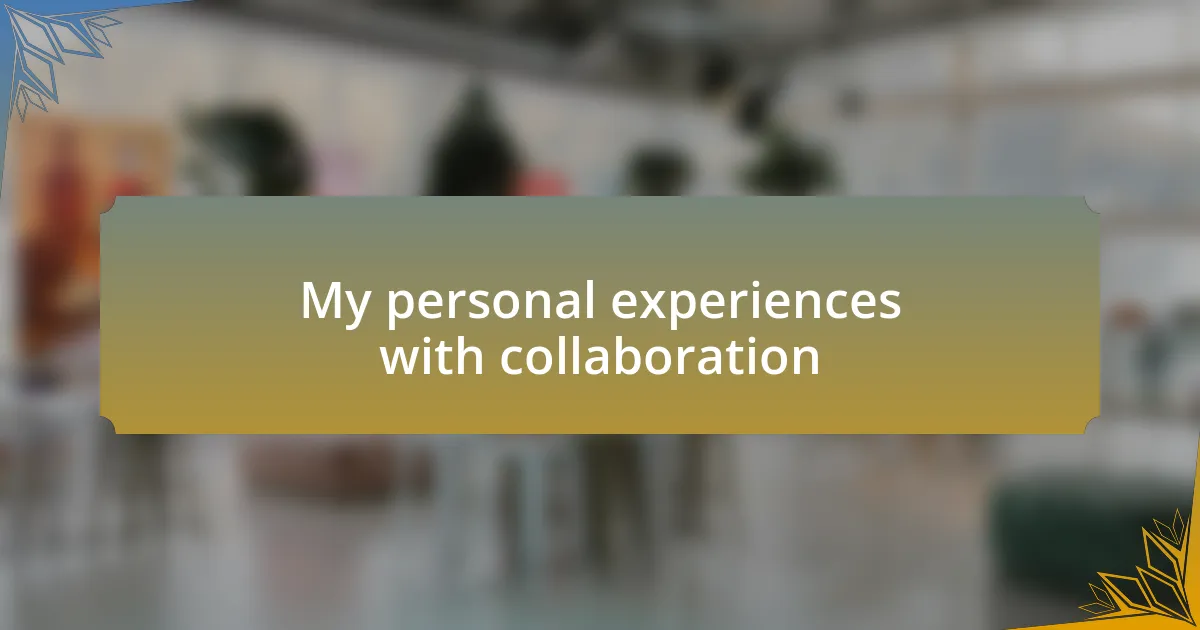Key takeaways:
- Cross-department collaboration enhances customer satisfaction by combining diverse perspectives and skills.
- Effective teamwork fosters agility and adaptability, facilitating quick responses to challenges and improved customer experiences.
- Establishing clear communication channels and involving team members early in decision-making are crucial for effective collaboration.
- Challenges in collaboration include differing priorities, misaligned communication styles, and time constraints that can hinder teamwork.

Understanding cross-department collaboration
Understanding cross-department collaboration is essential in achieving a cohesive customer experience. I remember a project where our marketing and sales teams had to come together. The initial hesitance quickly dissolved when we realized our shared goal was to enhance customer satisfaction, showcasing that collaboration breeds innovation.
It’s fascinating how different perspectives can lead to unexpected solutions. During one campaign, our data analytics team uncovered trends that my product development team hadn’t considered. Suddenly, we were not just building a product; we were creating something tailored to our customers’ needs, all because we decided to listen to one another.
Have you ever been part of a project that involved multiple departments? I once joined a brainstorming session where ideas flowed freely across teams. The energy in the room was palpable as we realized that collaboration often sparks creativity in ways we never expected, making everyone feel valued and engaged in the process.

Key benefits of cross-department teamwork
One of the most significant benefits of cross-department teamwork is the synergy created when diverse skills and experiences meet. I recall a situation where our customer support and product teams collaborated to address recurring client complaints. By combining their insights, they not only resolved issues more swiftly but also heightened the overall customer satisfaction. It struck me how working together transformed frustration into actionable solutions.
Additionally, fostering relationships across departments can lead to a more agile organization. I once participated in a sprint where marketing, design, and tech teams tackled a product launch. With clear communication and unified objectives, we adapted quickly to challenges and exceeded our launch goals. This experience taught me that flexibility thrives in environments where teamwork is prioritized, ultimately benefiting customer experience directly.
Lastly, cross-disciplinary collaboration fosters a culture of learning and adaptability. I’ve seen how teams that regularly interact develop a deeper understanding of each other’s challenges and strengths. This sense of empathy can lead to innovative strategies that consider various facets of customer interactions. Who doesn’t want a workplace where everyone is invested in finding smart solutions together? It’s a win-win that truly pays off in the long run.

Strategies for effective collaboration
Effective collaboration begins with establishing clear communication channels. In my experience, using collaborative tools like Slack or Trello has significantly improved transparency among teams. I remember when our project management was scattered; once we centralized our discussions, we reduced misunderstandings and enhanced our workflow. Isn’t it amazing how a simple shift can create such a profound impact?
Another strategy I’ve found vital is involving team members early in the decision-making process. When I led a cross-departmental initiative, I invited representatives from various teams to contribute their perspectives from the outset. This approach not only empowered individuals but also helped identify potential roadblocks early on. It makes me wonder—what untapped potential might we be missing out on if we don’t seek diverse inputs?
Lastly, celebrating joint successes can reinforce the collaborative spirit. After completing a complex project with multiple departments, we took a moment to acknowledge everyone’s contributions, and it felt rewarding. Sharing those victories fosters a sense of community and motivates teams to collaborate further in the future. How often do we take the time to recognize the collective effort that leads to success?

Challenges in collaboration at conferences
Coordination among departments at conferences often encounters the hurdle of differing priorities. I recall a time when marketing and product teams clashed over the event’s messaging. Each side was passionate about their vision, yet neither truly grasped the other’s objectives. This division not only created tension but also set us back in our planning. Have you ever experienced a situation where competing interests led to confusion instead of collaboration?
Another challenge lies in aligning communication styles. I’ve noticed that technical teams may lean toward data-driven dialogue, while creative teams thrive on storytelling. During one event, this disconnect hindered our ability to convey a unified message to attendees. Instead of working together, we spent more time deciphering each other’s jargon than focusing on the audience experience. It makes me think—how can we bridge these gaps to create a more cohesive narrative?
Lastly, time constraints can be a significant barrier to effective collaboration. When deadlines loom, I often find that departments prioritize their immediate tasks over collaborative efforts. I remember feeling the pressure during a major conference preparation, leading my team to skip important alignment meetings. In retrospect, I wonder how much smoother the process could have been if we had carved out those crucial discussions. Isn’t it essential to make that time investment for long-term success?

My personal experiences with collaboration
Collaboration at conferences has often been a double-edged sword for me. I vividly remember a project where the operations team and the design team were both eager to showcase their contributions. I was thrilled to see our ideas blending, but it quickly turned into a tug-of-war over who got the spotlight. Have you ever felt that rush of excitement, only to be jolted back by conflicting agendas? It taught me that balancing recognition is crucial for harmony.
One particularly memorable collaboration involved a cross-functional brainstorming session, which was a game-changer for us. Everyone brought unique perspectives, and I felt this palpable energy in the room. As we shared our thoughts, I realized that varied viewpoints could spark creativity. It made me wonder—what if we included more interactive workshops in future collaborations to harness this energy? The engagement in that room left a lasting impression on me.
However, it wasn’t always smooth sailing. I recall a conference where last-minute changes led to misunderstandings between teams. The programming team and the sales team had different interpretations of our audience’s needs. I felt a wave of frustration wash over me as we scrambled to address the confusion. In those moments, I’ve learned that proactive communication is essential. How can we better anticipate these challenges to enhance collaboration?